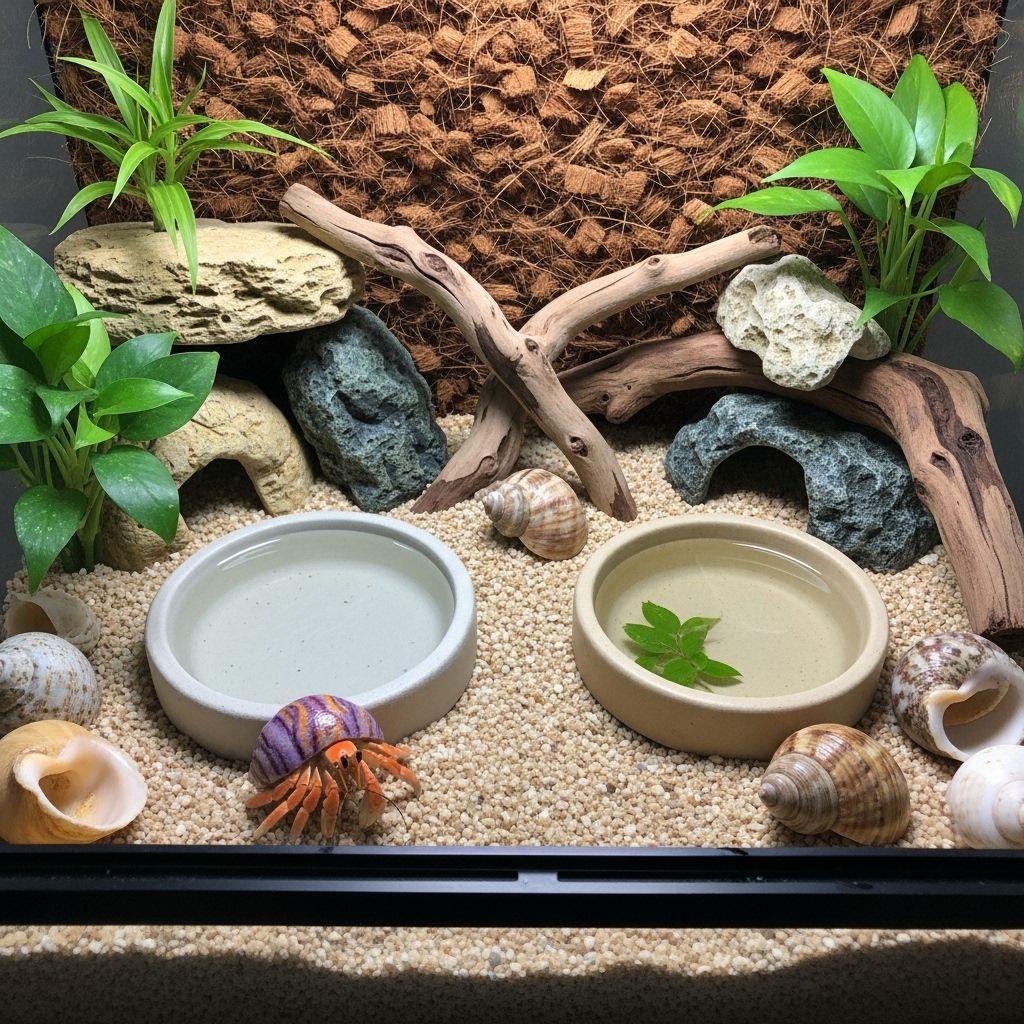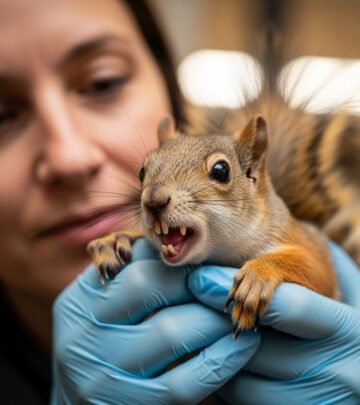Hermit Crab Habitat: Expert Tips For Building A Perfect Home
Learn how to create an ideal environment for your hermit crab to thrive and live a healthy life

Image: HearthJunction Design Team
How to Build the Perfect Hermit Crab Habitat
Many people mistakenly believe that all hermit crabs live in the ocean, but land hermit crabs—the most common type kept as pets—actually inhabit shoreline areas. This natural environment provides them with easy access to water when needed, whether for reproduction or moisture maintenance. Understanding this is crucial when creating a habitat for your pet hermit crab.
Contrary to their name, hermit crabs are social creatures that thrive in groups rather than in isolation. While they don’t require an elaborate home, proper temperature and humidity levels are essential to their health and survival. Coming from warm, tropical climates, land hermit crabs need a warm, humid environment to thrive. This comprehensive guide will help you set up an enclosure that provides everything your hermit crab needs to live a healthy, happy life.
Selecting the Right Tank
When housing hermit crabs, the enclosure is one of the most important considerations. Despite what some pet stores might suggest, those small plastic containers marketed as hermit crab homes are generally inadequate for long-term housing.
Tank Size Requirements
For proper hermit crab housing, consider these important size guidelines:
- A 10-gallon glass aquarium is the minimum recommended size for small or medium crabs
- Each crab needs at least 5 gallons of space, with more room required as they grow larger
- For long-term housing, larger tanks are always better—hermit crabs are more active than many owners realize
- For baseball-sized crabs, a 75-gallon or larger tank is the most suitable home
- If keeping multiple crabs (recommended since they’re social), increase the tank size accordingly
Remember that hermit crabs can grow surprisingly quickly. That tiny crab you bring home could potentially require a much larger enclosure within a year or two. Providing adequate space prevents overcrowding and ensures each crab has enough room to molt safely, which is crucial to their health and development.
Tank Material
Both glass and plastic tanks can serve as suitable homes for hermit crabs. However, glass aquariums tend to be the preferred option for several reasons:
- Glass tanks retain heat and humidity better than many plastic options
- Glass is more durable and scratch-resistant
- Glass aquariums typically have better fitting lids, which helps maintain proper humidity levels
Tank Cover
A secure lid is non-negotiable for hermit crab enclosures. These creatures are surprisingly strong and excellent climbers. A sliding glass lid works particularly well as it helps contain humidity while providing easy access for feeding and maintenance. The lid should allow for some air circulation while preventing escapes.
Creating the Perfect Substrate
Substrate is not just the floor of your hermit crab’s home—it’s a vital part of their environment that enables natural behaviors like digging and molting.
Substrate Type
Play sand is widely regarded as the best substrate choice for hermit crabs. It closely mimics their natural environment and allows them to dig and burrow effectively. The substrate should be kept slightly moist (but not wet) to help maintain humidity and allow for tunnel construction.
Substrate Depth
The depth of your substrate is critically important, especially for molting purposes:
- Maintain substrate depth at least twice as high as your largest crab, plus an additional inch if possible
- For medium-sized crabs, aim for at least 4-6 inches of substrate
- Deeper substrate allows crabs to completely bury themselves during molting, which is essential for their safety and health
Insufficient substrate depth can lead to dangerous and potentially fatal molting complications, as hermit crabs need to bury themselves completely during this vulnerable process.
Maintaining Proper Temperature and Humidity
Creating the right climate within the enclosure is perhaps the most critical aspect of hermit crab care. In the wild, these creatures enjoy tropical temperatures and high humidity levels, which must be replicated in captivity.
Temperature Requirements
Hermit crabs thrive within a specific temperature range:
- Daytime temperatures should be maintained between 75-85°F (23-29°C)
- Nighttime temperatures can drop slightly to 65-75°F (18-24°C)
- Use a reliable thermometer to monitor the temperature consistently
Heating Options
Several heating methods can help maintain appropriate temperatures:
- Under-tank heaters are the most popular choice, as they provide gentle, consistent heat without drying out the habitat
- If using an under-tank heater, ensure it’s covered with at least an inch of substrate to prevent crabs from getting too hot
- Heat lamps can be used but must be monitored carefully as they can reduce humidity
- Temperature-controlled heating pads provide more precise climate control
Humidity Control
Maintaining proper humidity is essential for hermit crab respiratory health:
- Ideal humidity levels range between 70-80%
- Use a hygrometer to accurately monitor humidity levels
- Mist the enclosure with dechlorinated water as needed to increase humidity
- Including a humidity mister or spray bottle with dechlorinated or salt water can help maintain proper levels
Low humidity can damage hermit crabs’ modified gills, leading to suffocation. This makes humidity maintenance one of the most important aspects of hermit crab care.
Lighting
While hermit crabs don’t require special lighting, a regular day/night cycle helps maintain their natural behaviors:
- Use a fluorescent or LED bulb in the terrarium hood for 8-12 hours daily
- High-output UVB lighting is not necessary or recommended for hermit crabs
- Ensure the lighting doesn’t interfere with temperature regulation
Essential Habitat Furnishings
The interior of your hermit crab habitat should include several key elements to create a stimulating and functional environment.
Climbing Structures
Hermit crabs love to climb and explore. Provide a variety of climbing options such as:
- Driftwood or sanitized branches
- Coconut fiber backgrounds
- Safe plastic plants or decorations
- Commercial hermit crab climbing toys
- Cork bark or other natural materials
Ensure all climbing structures are stable and won’t collapse if crabs climb on them. Avoid painted items or those with sharp edges that could harm your pets.
Shell Selection
One of the most important furnishings for hermit crabs is a variety of shells for them to move into as they grow:
- Provide multiple shell options per crab (at least 3-5 per crab)
- Offer shells slightly larger than their current home
- Include different shapes and opening styles
- Ensure shells have smooth openings without cracks or damage
- Place shells throughout the habitat, not just in one location
Having an abundance of shell options prevents shell fights and allows crabs to select homes that best suit their individual preferences and needs.
Water Sources
Hermit crabs require access to both fresh and salt water:
- Use shallow, non-metal, non-porous dishes that allow crabs to easily climb in and out
- Provide one dish with dechlorinated fresh water
- Include a second dish with properly mixed marine salt water (using aquarium salt specifically for marine environments)
- Ensure water is deep enough for crabs to submerge their shells but not so deep that they risk drowning
- Always treat tap water with a dechlorinator before offering it to your crabs
Food Dishes
Proper feeding stations are important for hermit crab health:
- Use shallow, ceramic or other non-metal dishes
- Place food dishes on a stable surface where they won’t tip over
- Clean and refresh food daily, as hermit crabs are sensitive to mold and bacteria
Diet and Nutrition
While the main focus of this guide is housing, proper nutrition is closely tied to habitat maintenance:
- Offer commercial hermit crab pellets as a base diet
- Supplement with fresh vegetables like kale, broccoli, and carrots
- Include fruits such as apples, grapes, and bananas in moderation
- Provide protein sources like unseasoned cooked egg or small amounts of unseasoned seafood
- Consider specialized hermit crab foods from reputable sources that contain natural ingredients
Remember that hermit crabs are primarily nocturnal and eat very slowly. Small amounts of food offered in the evening and removed in the morning helps prevent spoilage.
Habitat Maintenance
Regular maintenance ensures a healthy environment for your hermit crabs:
- Spot clean the habitat daily, removing any uneaten food or waste
- Replace water dishes with fresh water every 1-2 days
- Check temperature and humidity levels daily
- Mist the enclosure as needed to maintain proper humidity
- Perform a partial substrate change every few months, being careful not to disturb molting crabs
Signs of a Healthy Habitat
A properly maintained hermit crab habitat should show these positive indicators:
- Active, exploring crabs, especially during evening hours
- Consistent temperature and humidity readings within the proper range
- Substrate that holds its shape when lightly squeezed but isn’t soggy
- No unusual odors (a properly maintained crab habitat should have minimal smell)
- Evidence of natural behaviors like digging, climbing, and shell exploration
Frequently Asked Questions (FAQs)
How many hermit crabs can I keep in a 10-gallon tank?
A 10-gallon tank can comfortably house 2-3 small to medium hermit crabs. Remember that each crab needs about 5 gallons of space, and they’ll need a larger tank as they grow.
How do I know if my hermit crab is molting or dead?
A molting crab will typically bury itself in the substrate and may remain inactive for weeks or months. A slight fishy smell can be normal during molting, but a strong rotting odor usually indicates death. Never disturb a buried crab, as it’s likely molting.
Can I use regular beach sand for my hermit crab habitat?
It’s not recommended to use sand collected from beaches as it may contain harmful pollutants, parasites, or salt content that can’t be properly controlled. Commercial play sand or sand specifically sold for hermit crabs is a safer option.
How often should I change the substrate in my hermit crab tank?
Complete substrate changes should be avoided if possible, as they disturb the environment and may interfere with molting crabs. Instead, spot clean regularly and perform partial substrate changes (⅓ to ½ of the substrate) every few months if needed.
Do hermit crabs need a heat lamp?
Most hermit crab keepers find that under-tank heaters work better than heat lamps, as lamps can dry out the habitat and reduce humidity. If using a heat lamp, monitor humidity levels closely and mist more frequently.
References
- https://www.hermitcrabassociation.com/pages/BasicHermitCrabCare.pdf
- https://www.petsmart.com/learning-center/fish-care/hermit-crab-care-guide/A0187.html
- https://www.thesprucepets.com/hermit-crab-housing-1236872
- https://www.grimmthedragon.com/hermit-crab-keepers-checklist/
- https://www.hermitcrabparadise.com/forums/viewtopic.php?t=1814
Read full bio of Anjali Sayee












